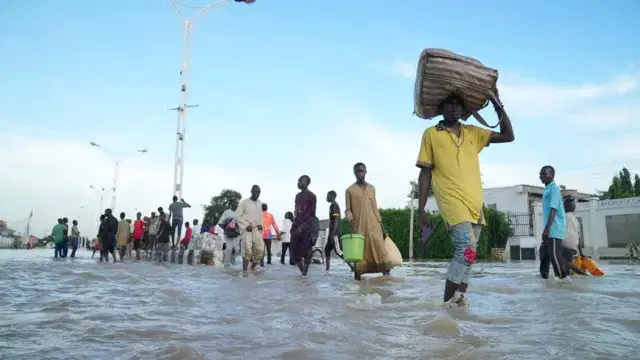•Our cry to fix major cracks fell on deaf ears – Survivor
Last Tuesday, many residents of Maiduguri and Jere Local Government Area of Borno State were displaced, no thanks to an “unavoidable” disaster that wreaked havoc on residents.
It was the third disaster in 32 years, the first two having occurred in 1992 and 2012 respectively.
Following the flood that submerged parts of Borno, an unspecified number of people and domestic animals lost their lives, with houses and critical infrastructures worth billions of naira wiped out.
The National Emergency Management Agency, NEMA, had said the flood began after the Alau Dam overflowed following heavy rains.
Experts also said a reason for the flood was the inflow of water into Alau and Jere Bowl which depends mainly on the inflow from Ngaddabul River.
They said the Ngaddabul River, a tributary of River Yedzeram, which originates in the Hudu Hills East of Mubi in Adamawa, flows northwest to Lake Chad.
While explaining that the dam is under the management of the Chad Basin Development Authority, experts told Sunday Vanguard that during the wet season, Yedseram River contributes massive inflow of water into the Ngaddabul River, which then flows into Alau and Jere Bowl.
According to them, during years of low rainfall, the Yedseram River does not contribute as much water to the Ngadda River.
Alau Dam
Constructed in 1984 and put to use in the year 1986, Alau Dam provides water for irrigation and domestic use in Maiduguri and serves as a means to control flood in the area.
However, Sunday Vanguard learnt that the dam has also been the cause of flooding in some cases.
In 1992, for instance, the dam reached its maximum level and spilled over, causing flood in Jere Bowl.
In 2012, torrential rainfall caused the Alau Dam to open its evacuation valve, releasing a massive amount of water that caused flood in Maiduguri and surrounding areas. On September 9, 2024, the dam collapsed following heavy rains that resulted in floods that inundated up to 40 per cent of Maiduguri and killed more than 80 per cent of animals in the Sanda Kyarimi Park Zoo.
- Past administrations
Checks revealed that various administrations including President Bola Tinubu have allocated funds for the dam’s rehabilitation. With N285 million in 2020 and N200 million in 2023, the highest allocations were made under the Muhammadu Buhari government.
The 2012, 2013 and 2016 budgets specifically described the repairs for which the Federal Government appropriated funds.
In 2012, for instance, N11 million was allocated for a desilting exercise and a hydrographic survey on the dam.
Another N12 million went to the reservoir desilting in 2013. More allocations followed, including N10 million in 2016 to rehabilitate dyke 1, 2 and 3 in the dam. Since 2017, however, the money for ongoing rehabilitation could not be properly appropriated for the purpose intended.
Experts, residents speak
Commenting on the incident, a 70-year-old resident of Gwange Ward, Usman Adams, recounted to Sunday Vanguard: “A flash flood from the Yedseram River caused extensive flooding in Maiduguri many years ago.”
Providing the root cause of the latest flooding, former Managing Director of Chad Basin Development Authority in Maiduguri, Engineer Abubakar Iliya, said: “Some of the factors include the total collapse of the two or three dykes, which led to overflow of the dam. There was also an incident of discharging water since January from the dam holes, with little or no spillway and the downpour experienced this year.”
A water irrigation engineer, who did not want his name in print, attributed the flood to negligence on the part of the government.
He said: “Had there been a proper check and management, the level of flood should not have been so devastating. The excess water should have been channeled to other usage or tributaries not directly linking the city of Maiduguri.”
Another resident of Alau Dam, who specialises in fish farming, said: “I have been into fishing business for the past 29 years, but this year, some of us witnessed some major cracks around the dam and the dykes. Consequently, we alerted the authorities, but all our concerns fell on deaf ears, hence the damage to lives and properties. It is very unfortunate.”
Casualties
No fewer than two million people are displaced and currently taking refuge at various camps, just as many are still trapped in the flood.
At press time, Gwom, Muna, 505 Housing Estate, Dikwa low-cost housing units and a host of others are still inaccessible, even as rescue teams battle to save lives and properties.
The Borno State government has, however, established a dedicated relief fund to provide urgent assistance to those affected.
The government has further pledged to mobilise support from citizens, organisations and international partners to alleviate the suffering of victims and expedite their recovery.
VANGUARD






